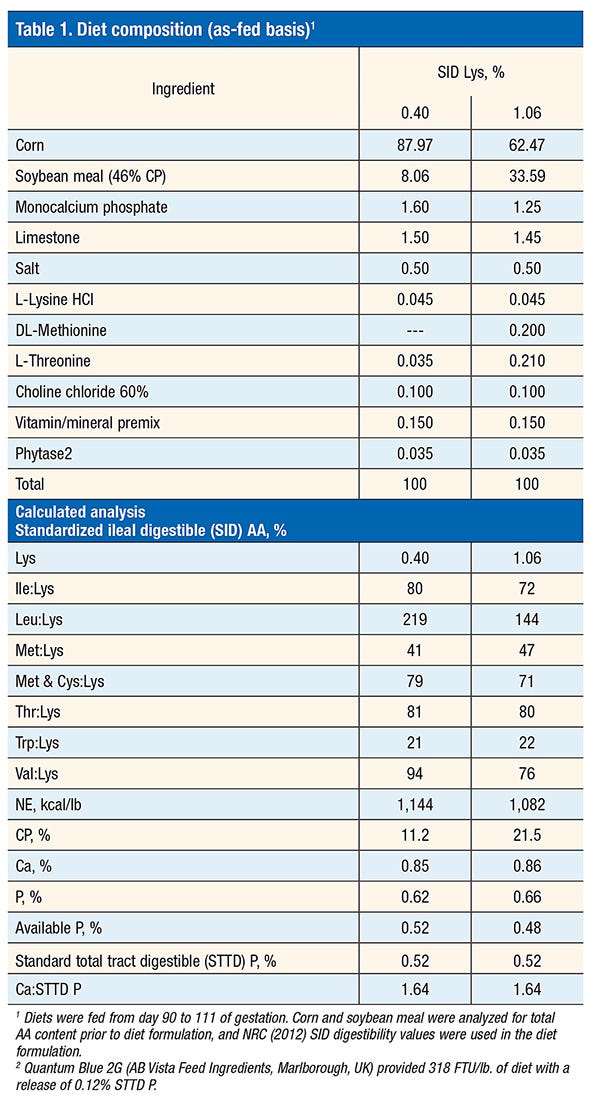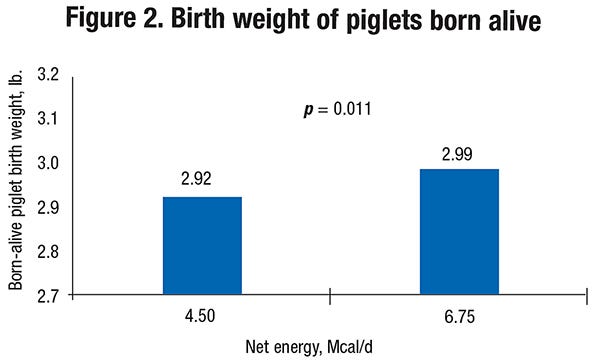January 5, 2016

Over the years, litter size has increased, which has reduced the uterine space available for fetal growth and development of piglets. As a result, individual piglet weights have decreased.
Pigs with a lower birth weight typically have less chance for survival or weigh less at weaning and market — all factors that can erode a farm’s profits.
A Kansas State University research team investigated nutritional options to improve piglet birth weight. In this study, researchers took a closer look at the effects of amino acids and energy content in late-gestation diets on piglets’ birth weights.
The research team used 1,102 group-housed females for this experiment. Starting at day 90 of gestation until farrowing, various nutritional treatments were utilized. The treatments were structured as a 2×2×2 factorial having two parity groups (gilts or sows), two standardized ileal digestible lysine intakes (10.7 or 20.0 grams per day), and two energy intakes (4.50 or 6.75 megacalories per day (Mcal/d) on a net energy basis. Two diets were formulated (Table 1) and delivered at four different ratios and intake levels to achieve the desired dietary treatments (Table 2). Other amino acids and nutrients met or exceeded the National Research Council 2012 requirements for swine. This commercial sow research facility used an electronic sow feeding system to deliver the dietary treatments daily. 

Looking at the results
For both gilts and sows, increasing lysine or energy intake boosted body weight gain, but the magnitude of response was greater when lysine and energy were increased together. Further, under high-energy intake, there were no differences in body weight gain between gilts and sows. However, sows fed low-energy intake had lower body weight gain than gilts.
Across the different nutritional treatments, there were no differences in total pigs born, as expected. Yet, sows under the high-energy intake had greater probability of stillborns, which resulted in reduction in the number of piglets born alive (Figure 1). Interestingly, this negative effect of high-energy intake on stillborn rate was not observed in gilts.
Diving into the data further, a 30-gram increase in piglets’ birth weight born alive was observed, and this effect was due to the energy rather than the amino acids (Figure 2). It is important to note that the effect of parity on birth weight was over three times greater (97 grams) than the effects of increasing energy intake. In addition, nursing piglets of females fed a high amino acid intake showed a lower percentage of preweaning mortality compared to those females fed low amino acid diets during late gestation, regardless of energy level.
Furthermore, the lactation length in sows and gilts was not affected by the various formulated diets. In the next reproductive cycle, there was also no evidence of difference on farrowing rate, total piglets born and born-alive piglets between the different maternal diets fed.
In conclusion, results showed:
■ Body weight gain of gilts and sows depended not only on energy, but also amino acid intake levels.
■ Sows fed an increased amount of energy had an increased stillborn rate, but that was not observed in gilts.
■ Increased energy intake during late gestation had a positive effect on individual piglet birth weight with no evidence for such effect for amino acid intake.
While increasing feed for sows and gilts in late gestation can improve body weight gain, it can also result in an increase in stillborn rates for sows. On the flip side, bump feeding of gilts had no negative impact.
Hog farmers need to evaluate the benefits over the costs in implementing bump feeding. If the cost of gestation feed is 12 cents per pound, there is a potential savings of $12.70 per sow per year by not bump feeding prior to farrowing, which is equivalent to almost a quarter of a million dollars for a production system with about 20,000 sows.
For more information, contact Márcio Gonçalves at 785-477-7758 or [email protected].
You May Also Like



